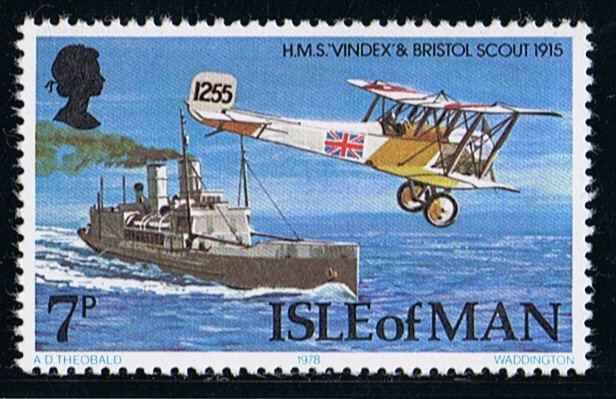

Built as a passenger ferry under yard No 759 by Armstrong, Whitworth & Co. Ltd. of Newcastle-on-Tyne for the Isle of Man Steam Packet Co. Ltd. of Douglas.
07 March 1905 launched under the name VIKING.
Tonnage 1.951 gross, 827 net, 2.950dwt. dim. 350.4 x 42.0 x 17.3ft.
Powered by three sets of Parsons direct acting turbines, 11.000 shp., speed 22 knots, three screws.. She was the first turbine driven vessel by the company. Coal fired.
Passenger accommodation for 1600 and 80 crew.
June 1905 delivered to owners. Building cost £83.900.
Used in the ferry service between Fleetwood and Douglas.
She made the passage in 1907 in a record time of 2 hours and 22 minutes with an average speed of 23.2 knots.
23 March 1915 requisitioned by the British Navy, and fitted out at Liverpool by Cammell Laird in a seaplane carrier. Fitted out with a large hangar aft and a smaller one forward, a flying platform with a length of 60 feet. Also cranes were installed for hoisting the planes back on board after there landing on the water.
Armament 4 – 12pdrs., 1 – 6pdr. AA guns.
11 August 1915 commissioned as HMS VINDEX.
She could carry 4 Short 184 seaplanes and additional she carried 4 single-seater Bristol Scout fighters, powered by 80hp Gnome engines, fitted out with wheels. The Bristol Scouts were landplanes on wheels as seen on the stamp.
After the flight and returning to the VINDEX they have to land near the vessel on the water, and kept floating by airbags until lifted from the water by the crane back on board.
11 October 1915 bought by the British Admiralty.
November 1915 joined the Grand Fleet at Harwich. On 5 November from her flying platform the first fighter aircraft was launched. This was the first instance of a land plane with a wheeled under-carriage taking off from the deck of an aircraft carrier. The plane was under command of Sub. Lieut. H.F.Towler.
The plane carried 48 Ranken Darts which could be fired in groups of three against Zeppelins, and on contact they would explode.
Still used for flying experiments at sea, which were successful, her Bristol Scouts planes were replaced by Sopwith 1½-Strutter fighters, who were fitted out with skids instead of wheels. This type was the first British aircraft fitted out with synchronizing gear, enabling the pilot to fire a fixed front gun through the arc of the propeller.
1918 She headed for the Mediterranean, operated there till the end of the war, and returned to Plymouth in March 1919.
April 1919 bought back by the Isle of Man Steam Packet Co. refitted in a passenger ferry and on July 1920 got her old name back, VIKING.
Again the next 10 years used in the passenger ferry service between Fleetwood and Douglas till 1930 when she was used for general duties.
Requisitioned the first week of World War II as a transport vessel from Southampton to Cherbourg, made her first sailing from Southampton on 11 September.
During a bombing she was damaged in the Thames Estuary, took not part in the Dunkirk operations due to this bombing and repair. Took part in the final evacuation of troops from St Valery she sailed from that port with 2000 troops to Le Havre on 12 June 1940.
15 June 1940 made a passage with troops from Cherbourg to Southampton and on 21 June from Guernsey to Weymouth. Her voyage from Guernsey was almost with the total juvenile population of the island, about 1800 school children were evacuated from St Peter Port to Weymouth.
After the evacuation from French was finished, she returned to the Island of Man Steam Packet service for a short time but requisitioned again from June 1942. Used as a Fleet Arm Target vessel, based at Crail the next seven months.
From December 1943 used as personnel ship and after D-day used in the cross-Channel service. Not used during D-day she was under repair after she was hit by a flying bomb while in the Surrey Commercial Docks in London. As a coal burner she was not so useful more for the Navy, due to lengthy and many coal bunkering.
1945 Bought back by the Isle of Man Steam Packet Co and refitted in a passenger ferry for the Fleetwood to Douglas service.
1947 Overhauled by Cammell Laird at Birkenhead and two years later her turbines were rebladed by the same yard.
14 August 1954 she made her last voyage in the service, and two days later under her own steam sailed for the shipbreaking yard of T. M. Ward of Barrow who had bought the VIKING. Arrived there 24 September 1954.
Her ship bell as remembering on her long association with Fleetwood was presented to the Borough of Fleetwood.
Isle of Man 1978 6p sg 107, scott 110 as HMS VINDEX
Isle of Man 1988 5p sg 368 as VIKING
Isle of Man 2005 26p sg? As VIKING.
Source: B.E.F. Ships before and after Dunkirk by John de S. Winser. Island Lifeline by Connery Chappell.
